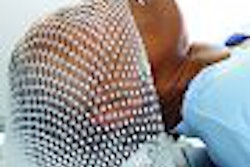A study from Switzerland concludes that low-dose prospectively gated coronary CT angiography (CTA) is both feasible and promising, but not without wrinkles.
Relying on prospectively triggered gating and some of the lowest radiation doses yet achieved for prospectively gated coronary CTA, the team reported that 95% of all coronary segments achieved diagnostic image quality. Still, overall image quality was very dependent on heart rate, and the results also suggested that image artifacts may be more common when scans are limited to a narrow exposure window.
For the past several years, the high radiation exposure associated with retrospectively gated coronary CTA has been a troubling topic of discussion as CT scans have become more frequent. And new modalities such as perfusion imaging can increase heart patients' exposure to ionizing radiation, the authors wrote in the European Heart Journal. Their study aimed to take the dose as low as possible.
"New CTCA acquisition protocols have been proposed with prospective electrocardiogram (ECG) triggering," noted study authors Dr. Lars Husmann, Ines Valenta, Oliver Gaemperli, and colleagues from University of Zurich in Switzerland. "With this, radiation is only administered at predefined time points of the cardiac cycle rather than the entire cardiac cycle.... The doses are expected to be far lower with use of prospective triggering; however, the technique has yet to be proven clinically," they wrote (European Journal of Radiology, December 19, 2007).
The study examined 40 patients (12 women, 28 men; ages 30-85 years, mean age 54.6 ± 13.0 years) who were scheduled for coronary CTA. Patients were evaluated for suspected coronary artery disease (CAD) based on at least one symptom including chest pain, abnormal exercise test or ECG, high risk factors, or known CAD. Candidates were excluded for the usual contraindications, including hypersensitivity to iodinated contrast, renal insufficiency, and nonsinus heart rhythm. One patient was excluded for atrial fibrillation.
Patients received 2.5 mg of isosorbiddinitrate sublingually. IV doses of 5-20 mg intravenous metropolol (Beloc, AstraZenica, London) were given for beta blockage if needed to reach a target heart rate of 65 bpm or less. A dose of 320 mg/mL of iodinated contrast (Visipaque 320, GE Healthcare, Chalfont St. Giles, U.K.) was administered prior to scanning, monitored by bolus tracking.
CTA images were acquired on a 64-slice scanner (LightSpeed VCT XT, GE Healthcare) using step-and-shoot mode acquisition at 64 x 0.625 mm, smallest x-ray window (75% of RR interval), and tube voltage adjusted by body mass index (BMI) that ranged from 100 mAs to 650 mAs for patients with BMIs of 30 and higher.
"By choosing the smallest possible window at only one distinct end-diastolic phase of the RR cycle (i.e., 75%), we ascertained the lowest achievable effective dose delivery," the authors wrote. The mean effective dose was 2.1 ± 0.6 mSv.
Two experienced readers independently evaluated the resulting images, assessing overall image quality on a five-point scale (1 = excellent) and measuring vessel attenuation in each coronary segment.
Overall image quality was diagnostic in 493 of 519 (95.06%) coronary artery segments 1.5 mm and larger, with excellent ratings in 269 (54.6%) of segments. There was minor blurring of the vessel wall in 166 (33.7%) segments, and 58 (11.8%) segments with minor artifacts (score 3). Still, image quality correlated strongly with heart rate and less significantly to BMI, the team explained.
"There was a significant impact of HR (heart rate), BMI, and vessel opacification on image quality, while the HR variability had no impact, (Spearman rank correlation coefficients for image quality and HR: r = 0.58, p < 0.001; BMI: r = 0.45, p < 0.001; vessel opacification: r = 0.56, p < 0.001; HR variability: r = 0.28, p = 0.069)," Husmann and colleagues wrote. "Similarly, in coronary segments with nondiagnostic image quality, HR was significantly higher (p < 0.001). However, BMI, vessel attenuation and HR variability did not significantly differ in diagnostic and nondiagnostic coronary segments (p = 0.89, 0.11, and 0.65, respectively)."
Image quality was also significantly lower in small coronary segments compared to larger ones (p < 0.05) and in segments with physiologically higher velocity (p < 0.001).
Diagnostic image quality was achieved in 93% of patients with a very low effective radiation dose of 1.1 mSv to 3.0 mSv when heart rates were below 63 bpm. Previous studies using retrospective gating have reported doses ranging from 7.8 mSv on an optimized dual-source scanner to 21.4 mSv at 64-slice CT, the authors noted.
The low mean effective dose of 2.1 mSv in the present study "is particularly important in view of the emerging field of hybrid imaging by integrating (coronary CTA) with nuclear techniques, as such the combination would result in considerable radiation exposure," they wrote. "Therefore any attempt to lower exposure seems welcome...."
The group succeeded in lowering mean HR to 57 bpm -- lower than many previous CTA studies. To achieve it, however, the authors said they had to administer slightly higher doses of IV beta-blocker in a greater percentage (75%) of patients compared to previous CTA studies.
"Nevertheless, we could still observe significant impact of HR on image quality in our study," they wrote. "Furthermore, we found a cut-off HR of 63 bpm below which low-dose (coronary CTA) is feasible in 93% of the patients with diagnostic image quality in all coronary segments."
As for limitations, Husmann and his colleagues noted the small cohort size, and wrote that no attempt was made to assess the diagnostic accuracy of the low-dose prospectively gated scans with comparable retrospectively gated studies. Finally, the image scoring method may have been biased by subjectivity, though high kappa values for interobserver agreement "may argue against such a bias," they wrote.
The low-dose acquisition technique "has great potential in combination with further refinements of CT scanners including higher rotation speeds and higher numbers of detectors," the group concluded.
In an editorial accompanying the report, Dr. Paul Schoenhagen from the Cleveland Clinic Foundation in Ohio called the Swiss study "an important contribution to the debate about cardiovascular CT. It is increasingly obvious that the desired optimal image quality has to be balanced against the potential long-term side effects of radiation exposure," he wrote (European Heart Journal, December 21, 2007).
Images were nondiagnostic in 5% of segments and 23% of patients. "Importantly, 46% of nondiagnostic segments were related to stairstep artifact at the junction of sequential image stacks," Schoenhagen wrote. "While such step artifacts and differences of contrast concentration are not specific to prospective triggering, they appear more prominent with this technique. Assessment of lesions at the level of these steps is expected to be a particular diagnostic problem. A technical solution will be data correction by slightly widening the acquisition window."
In their efforts to minimize the radiation dose, Husmann and colleagues chose the narrowest acquisition window, "and therefore have probably compromised diagnostic accuracy," Schoenhagen wrote.
By Eric Barnes
AuntMinnie.com staff writer
January 11, 2007
Related Reading
Low-dose coronary CTA diagnoses most patients, November 28, 2007
Radiation dose slashed in 64-slice coronary CTA, February 15, 2007
Step-and-shoot acquisition cuts CTA dose, improves images, January 16, 2006
Copyright © 2008 AuntMinnie.com


















